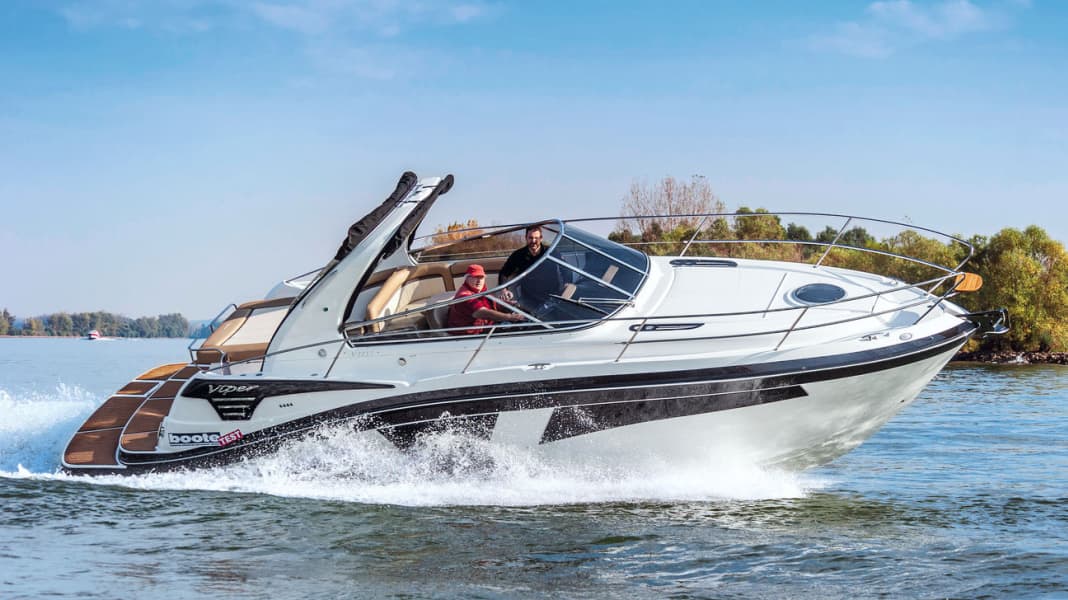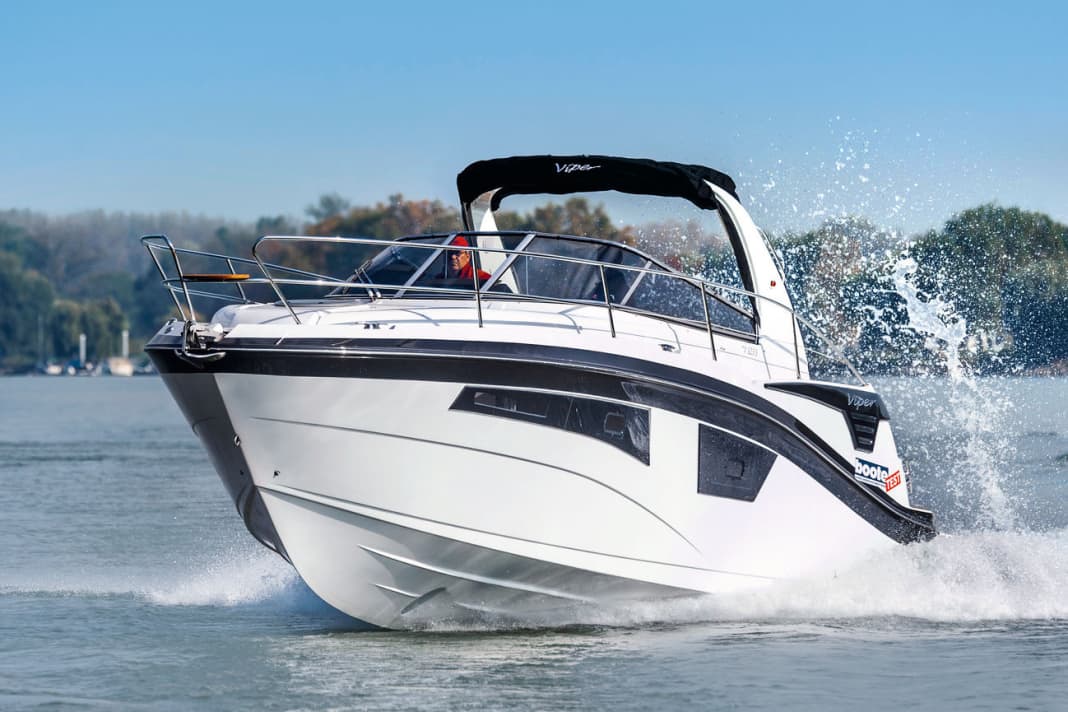






The fact that the company in Budenheim near MainzEurope Marine The word has got around that you can get fine motorboats that are manufactured in Germany and completed in-house. The products are called Vipers. The model selection is currently limited to seven from the V-series and two from the Toxxic series. Among them areour test boat V 323 in the HD version with or as S without hardtop.
We drive the S version, which stands for Sport. To ensure a sporty drive, a V 323 can be equipped with either one or twoDiesel or petrol engines with Z-drive and choose between outputs from 260 to 700 hp. We drive two V6 power plants, each with 250 hp and 4.5 litres of displacement, including exhaust gas purification, i.e. catalytic converters fromMerCruiser below deck plus Alpha-One-Z drives.
With regard to theentire processing our test boat ranks at the top level. "Heart, what more could you want" is available on the outside of the high-quality gelcoat for an extra chargein all RAL colours or metallic paint. Upholstery parts such as foam cores or covers are cut by computer-controlled machines and assembled by skilled hands. When it comes to wood construction, you can feel and see that carpenters andCarpenters with heart and mind were there.
Driving and manoeuvring
With oppositely engaged gearboxes, the V 323 Salmost on the spot Turning the steering wheel and with both gear levers set to "Forwards" or "Backwards", a turning circle measures about two boat lengths. It is also possible to turn from one side to the other directly. This facilitates manoeuvring at slow speed. TheStandard bow thruster is only needed in adverse wind or flow conditions. The motors and gearbox are operated via a mechanical control box, so you have to fiddle with the control levers a little to synchronise both motors at low speeds.
If we manage to get both V6s to turn at the same speed, our test boat will sail straight ahead at a slow speed (1500 rpm) and generate few waves at a speed of 6 knots. Without much trimming, our test boat begins to glide at 3000 rpm. With 150 rpm more than permitted by the manufacturer (5200 rpm), a top speed of just under 36 knots is logged in the GPS on the Rhine, and we measured the sprint from 0-60 km/h at 17.8 seconds. One tank of petrol is theoretically enough for a distance of just under 200 nm at slow speed plus 15% reserve. Economically, the test boat is travelling at a speed of 24 knots at a fast planing speed when the engines are turning 4000 rpm. One tank of fuel is enough for an acceptable 156 nm at a stretch and 111 nm at full throttle plus reserve. We rate the sound pressure values, which only break through the 85 dB/A barrier at 4500 rpm, as just "good".
The Viper V 323 S brakes down to its lowest gliding speed in the increasingly tight bends and follows its course without rocking or hooking. If the diameter of the curve is less than three boat lengths, the propellers reach into the void and demand a new start.
The test boat completes the extreme manoeuvres at full steam absolutely satisfactorily and the resulting centrifugal forces are sustainable. On the imaginary slalom course, the test boat is made to sway safely over its longitudinal axis, and when the rudder is jerked, it promptly follows the chosen course. For the rough water test, the waves of commercial shipping are used, which hardly challenge the hull of the V 323 S at all. The driver sits comfortably and draught-free in his bucket seat in front of an elaborately designed control station. Instruments and bright attachments are reflected in the windscreen.
Although it comes as standard, it only opens up a peephole in an emergency, so we devalue the windscreen wiper in front of the skipper. Analogue compass and depth sounder are standard. We criticise the steering for feeling too stiff, and at full throttle the hand on the gear lever touches the switches on the helm position in front of it. Co-drivers sit on a bench seat on the table on the port side without designated handholds. However, an insertable backrest at the front of the bench seat provides extra support.
Technology and safety
At the touch of a button on the cockpit galley, the engine compartment lid opens with a folding rear sunbed and large storage space underneath. "If you want to get into the engine compartment, it's time to get down on your knees and move backwards. Plenty of space and room to manoeuvre make it easier to carry out inspections and servicing. You can see plenty of insulation material and neatly fastened cables and hoses as well as batteries in sturdy plastic boxes.
Praise: separate fuel pre-filter. Criticism: no water alarm. Good: Solenoid valves regulate the fuel flow and an automatic fire extinguishing system that extinguishes fires. The main battery switches are operated at the rear entrance behind a lockable cover in the cockpit side wall and circuit breakers in the electrical panel in the saloon.
Good and safe driving characteristics and neatly dimensioned side decks with their own steps at the rear score points. However, when the soft top is up, it lacks the support that the rear railing, grab handles on the equipment carrier and a sturdy railing would otherwise provide. The door at the rear entrance is too low for us, but we like the hand bilge pump and the cockpit that can be steered outboard.
The swim ladder is criticised for its handling - it has a hinged lid and is awkward to operate from the water. Although there is a handle, if you hold on to it, the lid and handle move and you lose your grip. Therefore only "sufficient".
Indoors and outdoors
You enter the boat either by climbing over the railing onto the side decks or from aft via the bathing platform and stern entrance on the starboard side. The stern sunbed on the engine compartment lid dominates the aft section, with a cockpit bar with sink and refrigerator in the centre and a bench seat, table and driving position forward. An equipment carrier, which is also part of the canopy, is enthroned above everything. Nothing needs to be converted if someone wants to sit and sunbathe. If the rear lounger is not enough, you can buy the sun cushions for the foredeck.
Once you have passed through the plastic sliding door into the living area, the successful ambience is impressive. The materials appear to be of high quality and nothing distracts the eye. The bow section of the V 323 S is adorned with a large, V-shaped bench seat with table that can be converted into a lounger. To port, a compact galley, which is complete apart from an active ventilation system to the outside, is located aft. Opposite, you enter a WC/shower room with toilet with a pleasantly spacious feel.
The separate underfloor cabin below the cockpit is unexpectedly large. Behind the entrance door, the headroom varies without giving the feeling of being cramped, especially when sitting on the small bench on the port side. Well thought out: In the cabin, which extends across the entire width of the boat, both single berths can be converted into a large king-size berth by means of shelves and cushions. What is missing is ventilation underneath. The fact that there is also plenty of storage space and shelves below deck is part of the V 323 S concept, as every available space is optimally utilised.
Equipment
Europe Marine equips the Viper V 323 S extensively, with essentials such as cockpit tarpaulin, depth sounder and compass as well as the electric anchor winch with bow fitting as standard. There is also no shortage of mooring cleats and towing eyes. However, there is a shortage of navigation lighting, where the fitter fitted international lamps instead of BSH-certified lamps, which we devalue. The future owner will find more accessories for customising the boat on the extra list. If this all sounds familiar, you may remember the BOOTE test of the predecessor model Viper 303 in the August 2011 issue.
CONCLUSION
The Viper 323 S is a cabin cruiser for relaxed travelling or just cruising. It looks good, has a certain flair, shows good workmanship and professional installations. She is a worthy successor to the 303.

